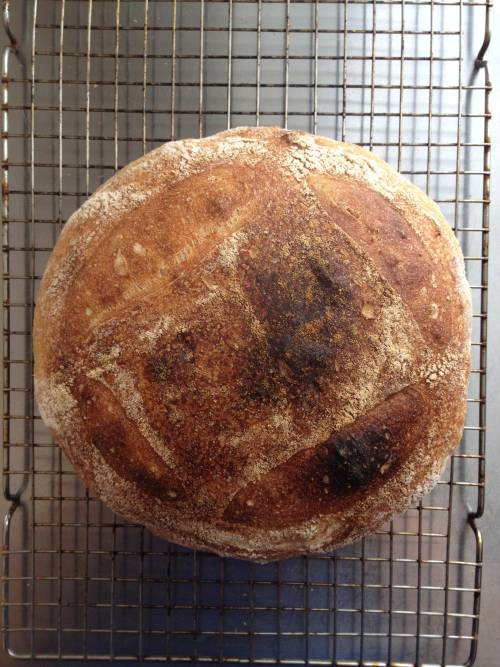Hi everyone,
I think I may have made my best loaf yet yesterday. But one thing that I'm still reaching for is Big Ears!
I live in San Francisco and am using the Tartine Country Bread recipe/process with overnight proofing in the fridge.
Baking happens in a dutch oven. And this is what I end up with. Great crumb with good holes.
But what about the big crusty ears? Could it be that my dutch oven is not sealing in enough moisture?
Thanks in advance for your opinions!

Hi Tangy. Welcome to the site!
A good place to start is by checking out DMSnyder's Scoring Bread Tutorial.
I still don't have a great feel for it and my loaves typically come out looking like yours, which isn't bad, but it isn't ideal either. Other folks here may have some other helpful tips for you.
Cheers,
-Floyd
Hi, Tangy.
Traditionally, "big ears" are desireable in long loaves like baguettes, not in boules. However, if you want to understand how to get them, read the section on "What's the point of an ear" in the Scoring Tutorial. Floyd's reply, above, has the link.
I think your boule looks very nice.
David
Thanks for the nice comment - and for writing such an in-depth tutorial on scoring. Reading over it now!
Score almost parallel to the surface...and be bold! :-) See my post under Tartine bread. One of them has particularly nice ears.
As it happens, these two boules came out of my oven this afternoon:
Close-ups illustrate my points about ears on boules.
This is a typical boule scored in a traditional "tic tac toe" pattern. Note that there is some elevation of the crust between the bloom, but it is minimal. It does show that my proofing was ideal. If I had underproofed, there would have been bursting and a less even bloom. If I had over-proofed, the whole surface would have been flatter, and there would be less bloom.
The other boule could be regarded as "the exception that proves the rule."
This was scored with a half-moon cut around the margin of the top plus three slashes across the top. It has a "kind of, sort of ear."
This developed because the first slash was made with the blade at a shallow angle to the surface of the loaf. The cuts on top, which don't have ears, were made with the blade perpendicular to the surface.
By way of contrast, below is a photo of a baguette I baked last week.
These cuts were all made with the blade at a shallow angle to the surface. There are a few more important points, but these are covered in the Scoring Tutorial.
I hope this helps.
Happy baking!
David
This is immensely helpful, David! What beautiful bread you've got :)
So by your description, my bread is flatter, therefore overproofed?
The bloom pattern on your loaf does suggest slight over-proofing. There is really nothing wrong with it, but the Tartine basic country bread usually has pretty exhuberant oven spring and bloom. That pattern could also be partly due to the cuts being too shallow.
David
Got it, David! I'll try deeper scores next time. Given that the proofing is happening in the fridge, I'll also try to leave it in there for just 8 hours versus the 12 that it went through for this loaf.
I'll report back on the results :) THANK YOU!
Hey bakers,
In the last couple of months I've "perfected" (should say "made a lot of progress on") my EAR scoring technique. I love trying to get an ear on a sourdough batard, so when I finally started achieving them consistently, I wrote down exactly how I did it. For me, it comes down to (1) shaping the batard with proper tension and (2) scoring the dough at a decently shallow angle.
In this video I show how I typically get an ear on sourdough bread...
Thanks for posting the video. I am new to Sour Dough and am trying to figure out how to create a crust that can actually be cut through with a regular bread knife and how to develop the ear! So this was great! It was suggested to use steam. I have not had a chance to try it yet. I couldn't tell, are you using steam in your oven? Curious.